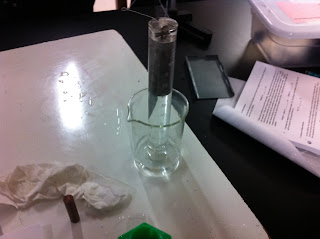Spring Wave Lab
The purpose of this lab was to determine a relationship between wavelength and frequency, and if there is a relationship, to determine whether this relationship is linear or not.
A large and long spring was used as a medium to transfer transverse waves. Instead of changing the wavelength by generating many more nodes of standing waves, our group used a different approach. The wavelength was adjusted by changing the length of the spring that was used to generate transverse waves, because λ=2L. We generated transverse standing waves at lengths of 1.5m, 2m, 2.3m and 3m. For each length of spring, we recorded the amount of time that would take for the spring to oscillate 5 times. We repeated this measurement multiple times to get an idea of the uncertainties involved. The data collected and the calculations are below:
Analysis
As mentioned earlier, the wavelength was calculated by multiplying the length of the spring used by two. For example, λ = (1.5m ±0.005m)( 2)= 3m ± 0.01m. The frequency was calculated by using its definition, f=cycles/second. For example, the frequency for the 3m wavelength was calculated as: f = 5 cycles/6.14 ±20s = 0.81Hz ±0.05Hz. Finally, graphing the wavelength verses the frequency gives the graph below:
Conclusion
Looking at the graph, it is clear that there is a linear relationship between frequency and wavelength. As the wavelength is increased, the frequency correspondingly decreases. It is interesting to note that two of the data points are above the trend line, while two are below. The uncertainties relating to the wavelength is due to our ability to correctly measure the spring using a large 2-meter stick, and to correctly hold that measured length during that phase of the experiment. The Uncertainties due to the time per 5 cycles is naturally from our team member’s ability to correctly count and pause the stopwatch each 5 cycles. Finally, the uncertainty related to the frequency is naturally derived from the uncertainties related to the time.











_IOXF.jpg)




